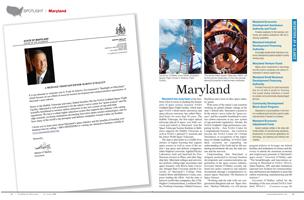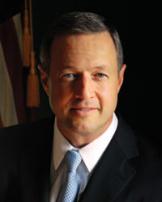
Maryland has long been at the forefront when it comes to pushing the boundaries of space science research. NASA Goddard Space Flight Facility, which manages NASA’s observation, astronomy and space physics missions, has called Maryland home for more than 50 years. The Hubble Telescope, the first major optical telescope placed in space, was built, serviced and rebuilt in Maryland. And the Space Telescope Science Institute in Baltimore supports the Hubble Telescope as well as NASA’s optical/UV missions and the James Webb Space Telescope.
The state is also home to a wealth of institutes of higher learning that support space science as well as some of the nation’s top space and defense companies. Johns Hopkins University Applied Physics Laboratory built and launched the New Horizons mission to Pluto, and other flagship labs. Maryland colleges and universities perform cutting-edge aeronautics and space research, with Bowie State University, Morgan State University and the University of Maryland’s College Park, Eastern Shore and Baltimore County campuses leading the effort. And the state is home to world-class companies, like ATK, Hughes Communications, Lockheed Martin, Northrop Grumman, Orbital Sciences, Raytheon and a host of other space industry giants.
 |
Governor O'Malley tours NASA Goddard Space Flight Center's Wallops Flight Facility. |
With some of the nation’s top scientists working on global climate change at the state’s federal labs, Maryland is poised to be the nation’s nerve center for “green science” and the scientific beachhead to monitor carbon emissions in any new system of cap-and-trade regulations. Already, the NASA Goddard’s high performance computing facility – then NASA Center for Computational Sciences – has evolved to become the NASA Center for Climate Simulation, in recognition of the importance of climate modeling. At NASA Goddard, scientists are expanding our understanding of the Earth and its life-sustaining environment, the sun, the solar system and the universe. In collaboration with NASA, the National Oceanic and Atmospheric Administration develops systems that enhance our comprehension of the role oceans, coasts and the atmosphere play in the global ecosystem.
Understanding that Maryland is uniquely positioned to increase business development and commercialization opportunities in the space science industry, Governor Martin O’Malley recently outlined new policy initiatives and industry investments through a comprehensive research report, Maryland: The Business of Space Science.
“Working side-by-side with our congressional delegation and our 'Space Senator,' Barbara Mikulski, we will pursue program policies to leverage our federal facilities and institutions of science and discovery to unlock the enormous economic and employment potential of Maryland’s space sector,” Governor O'Malley said. “The breakthroughs and innovations occurring in Maryland at NASA, NOAA, Johns Hopkins, APL and other institutions represent new frontiers for commercialization and business development in areas like carbon monitoring, manufacturing and life sciences."
Governor O’Malley called for the branding of the area around NASA Goddard, NOAA’s Silver Spring and Suitland campuses, and University of Maryland as the “Climate Corridor” and outlined a four-point plan to:
Exploit and enhance Maryland’s leadership in R&D in space and earth science
Commercialize space technologies to create new products, new wealth and new employment
Promote launch activity at Wallops and create jobs on the Eastern Shore
Educate and train Marylanders for the space and earth science sectors
"We applaud Governor O’Malley and the State of Maryland for taking a bold stance to support new exploration and discovery in space and earth science,” said Dr. Matt Mountain, director of Hubble's Space Telescope Science Institute in Baltimore. “Their support can bring together Maryland’s world-class scientific assets and entrepreneurial industries to exploit the technological and commercial opportunities which will be the foundation of job growth and Maryland national leadership in the space enterprise."
“The first step toward fast-forwarding an emerging technology economy in the region is to articulate and launch this very strategy,” said Maurice B. Tosé, chairman and CEO of Annapolis-based TeleCommunication Systems, Inc. (TCS). “Maryland is home to the best and the brightest science and engineering professionals and universities on the planet. This initiative demonstrates how business and government can collaborate to innovate and, in the process, create a robust economic asset for the state.”
The state also plans to create a Space Development office within the Maryland Department of Business & Economic Development (DBED), establish a space-related business incubator, advocate for a proposed National Center of Climate & Environmental Information and expand manufacturing of satellite instruments and their components.
“Our journey toward making Maryland the Space Science State begins with the appointment of a Space Advisor – the first step in the
 |
The James Webb Space Telescope, NASA, will be the premier observatory of the next decade, serving thousands of astronomers worldwide. |
creation of the Space Development Authority at DBED,” said DBED Secretary Johansson. “Maryland’s space science industry offers tremendous opportunity for our state, not only in space exploration and in discovery of the unknown, but also in growing Maryland businesses, creating jobs and expanding the industry. With our partners in the public and private sectors and in academia, the Space Advisor and the Space Development Authority will spearhead this space science initiative."
Governor O’Malley also recognized the importance of NASA’s Wallops Flight Facility to Maryland’s space science industry and economy. Located on Virginia’s Eastern Shore, just five miles from the Maryland border, Wallops has an economic impact of more than $188 million and generates 2,341 jobs for the Lower Eastern Shore region.
"Fifty years after President Kennedy called for our country to send a man to the moon, America is no longer in a space race - we’re in a race for our economic future. To win that race we must again work together to out-innovate, out-educate and out-build,” said Senator Barbara A. Mikulski. “That’s why I fight so hard to invest in Maryland’s federal assets like NASA Goddard, NOAA and NIST. I will continue to work with Governor O’Malley in support of Maryland Space Tech, so we can keep leveraging our federal investment to create jobs in space science, space flight and satellite servicing.”
The initiative will further enhance what is a growing economic engine for Maryland, with the potential to become increasingly so due to the state’s federal facilities, universities, research institutions and military installations.
Each year, NASA contracts $1.4 billion with Maryland companies. NASA’s 10,000 employees and thousands of other Marylanders work in space enterprises related to NASA, NOAA, the U.S. Geological Survey and national security agencies. In addition, Maryland has the highest concentration of astronomers in the country – 11 times the national average – easily the top state in the nation. According to the Space Foundation’s definition, there are nearly 18,000 “space jobs” in Maryland including atmospheric and space scientists, avionics technicians and astronomers. The average annual space science salary is $110,000 – more than double the private sector average salary.

